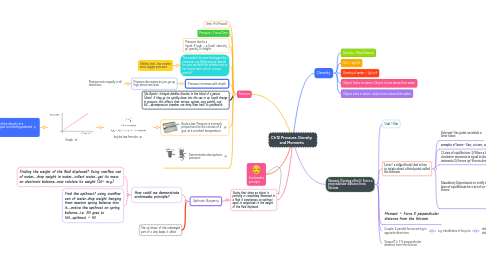
1. Pressure
1.1. Unit= Pa (Pascal)
1.2. Pressure = Force/Area
1.3. Pressure due to a liquid...P=pgh......p (row) =density, g= gravity, h=height
1.4. The smaller the area the bigger the pressure...e.g. 80kg woman stands on your toe with her stiletto heel vs her runner heel...which is more painful?
1.4.1. Stilleto heel...has smaller area...bigger pressure
1.5. Pressure increases with depth
1.5.1. Pressure decreases as you go up high above sea level
1.5.1.1. Pressure acts equally in all directions
1.6. The Bends= nitrogen bubbles dissolve in the blood of a person (diver) if they go too quickly down into the sea or up (rapid change in pressure...this affects their nervous system...very painful...can kill.....decompression chamber can bring diver back to goodhealth.
1.7. Boyles law: Pressure is inversely proportional to the volume of a gas, at a constant temperature
1.7.1. boyles law formula
1.7.1.1. Graph
1.7.1.1.1. Hydrometer: instrument used to find the density of a liquid...Uses: to test that alcohol in pub is not being watered down. (or farmers milk)
1.8. Demonstrate atmospheric pressure:
2. Archimedes principle
3. States that when an object is partially or completely immersed in a fluid it experiences an upthrust equal in magnitude to the weight of the fluid displaced.
3.1. Upthrust= Buoyancy
3.1.1. How could we demonstrate archimedes principle?
3.1.1.1. Finding the weight of the fluid displaced? Using overflow can of water....drop weight in water...collect water...get its mass on electronic balance...now calulate its weight (W= m.g)
3.1.1.2. Find the upthrust? using overflow can of water..drop weight hanging from newton spring balance into it....notice the upthrust on spring balance...i.e. 5N goes to 4N...upthrust = 1N
3.1.2. The up thrust of the submerged part of a ship keeps it afloat
4. Density
4.1. Density = Mass/Volume
4.2. Unit = kg/m3
4.3. Density of water = 1g/cm3
4.4. Object floats on water= Object is Less dense than water
4.5. Object sinks in water= object more dense than water
5. Moment (Turning effect)= Force x perpendicular distance from fulcrum
5.1. Unit = Nm
5.2. Lever= a ridged body that is free to rotate about a fixed point called the fulcrum
5.2.1. Fulcrum= the point on which a lever turns
5.2.2. examples of levers= Door, scissors, see-saw, spanner
5.2.3. 2 Laws of equilibrium- 1) When a lever is balanced the sum of the clockwise moments is equal to the sum of the anticlockwise moments 2) Forces up=Forces down
5.2.4. Mandatory Experiment: to verify the laws of equilibrium for a set of co-planer forces
5.3. Moment = Force X perpendicular distance from the fulcrum
5.4. Couple: 2 parallel forces acting in opposite directions
5.4.1. e.g. handlebars of bicycle
5.4.1.1. distance between two handles = distance
